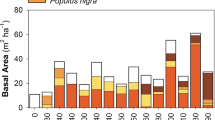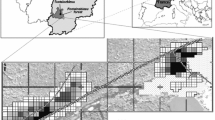Abstract
Aims
To assess the impacts of Ailanthus altissima and Robinia pseudoacacia on the whole litterfall process and on soil properties of riparian ecosystems of Central Spain by comparing invaded and non-invaded forests.
Methods
We selected 3–4 plots of four different types of forests: invaded by A. altissima or R. pseudoacacia, or dominated by the native Fraxinus angustifolia or Populus alba. In each plot we collected the litter monthly over 2 years and separated the litter from different plant organs. We calculated annual inputs of litter, nitrogen (N) and phosphorus (P) to soil. We also analyzed soil pH, organic matter (OM), N and P.
Results
Most litter fractions from the two invasive trees contained over twice as much N as those from the native P. alba. Although not significantly different, the annual inputs of N in invaded forests were 1.7–2.2 times higher than in native forests. In the invaded forests, extra litterfall peaks were found in summer and/or late-spring (June), corresponding to reproductive and/or leaf litter fractions. The percentage of annual litter represented by these peaks was over twice those in native forests. Soil OM, N and P were higher in invaded than in P. alba forests. In addition, forests invaded by R. pseudoacacia had higher soil OM and N than F. angustifolia forests.
Conclusions
This study showed the capability of A. altissima and R. pseudoacacia to alter soil properties and litterfall dynamics in riparian ecosystems.




Similar content being viewed by others
References
Abelho M (2001) From litterfall to breakdown in streams: a review. Sci World 1:656–680. doi:10.1100/tsw.2001.103
Abelho M, GraÇa MAS (1996) Effects of eucalyptus afforestation on leaf litter dynamics and macroinvertebrate community structure of streams in Central Portugal. Hydrobiologia 324:195–204. doi:10.1007/BF00016391
Allen SE, Grimshaw HM, Parkinson JA, Quarnby C (1974) Chemical analysis of ecological materials. Blackwell, Oxford
Bastow JL, Preisser EL, Strong DR (2008) Holcus lanatus invasion slows decomposition through its interaction with a macroinvertebrate detritivore, Porcellio scaber. Biol Invasions 10:191–199. doi:10.1007/s10530-007-9122-0
Bolker BM, Brooks ME, Clark CJ, Geange SW, Poulsen JR, Stevens MHH, White JSS (2009) Generalized linear mixed models: a practical guide for ecology and evolution. Trends Ecol Evol 24:127–135. doi:10.1016/j.tree.2008.10.008
Bray JR, Gorham E (1964) Litter production in forests of the world. Adv Ecol Res 2(10.1016/S0065-2504(08)60331-1):101–157
Castro-Díez P, González-Muñoz N, Alonso A, Gallardo A, Poorter L (2009) Effects of exotic invasive trees on nitrogen cycling: a case study in Central Spain. Biol Invasions 11:1973–1986. doi:10.1007/s10530-008-9374-3
Castro-Díez P, Fierro-Brunnenmeister N, González-Muñoz N, Gallardo A (2012) Effects of exotic and native tree leaf litter on soil properties of two contrasting sites in the Iberian Peninsula. Plant Soil 350:179–191. doi:10.1007/s11104-011-0893-9
Castro-Díez P, Valle G, González-Muñoz N, Alonso A (2014) Can the life-history strategy explain the success of the exotic trees Ailanthus altissima and Robinia pseudoacacia in iberian floodplain forests? PLoS ONE 9(6), e100254. doi:10.1371/journal.pone.0100254
Cesarz S, Fahrenholz N, Migge-Kleian S, Platner C, Schaefer M (2007) Earthworm communities in relation to tree diversity in a deciduous forest. Eur J Soil Biol 43:61–67. doi:10.1016/j.ejsobi.2007.08.003
Chytrý M, Maskell LC, Pino J, Pyšek P, Vilà M, Font X, Smart SM (2008) Habitat invasions by alien plants: a quantitative comparison among Mediterranean, subcontinental and oceanic regions of Europe. J Appl Ecol 45:448–458. doi:10.1111/j.1365-2664.2007.01398.x
Cierjacks A, Kowarik I, Joshi J, Hempel S, Ristow M, Von der Lippe M, Weber E (2013) Biological Flora of the British Isles: Robinia pseudoacacia. J Ecol 101:1623–1640. doi:10.1111/1365-2745.12162
DAISIE (2009) European invasive alien species gateway. http://www.europe-aliens.org. Accessed 6 Nov 2013
De la Cruz M, Peinado M (1996) El paisaje vegetal de la cuenca del río Henares, I. comunidades arbóreas y arbustivas. Wad-Al-Hayara 23:335–396
Ellis LM, Crawford CS, Molles MC Jr (1998) Comparison of litter dynamics in native and exotic riparian vegetation along the Middle Rio Grande of central New Mexico, U.S.A. J Arid Environ 38:283–296. doi:10.1006/jare.1997.0334
Facelli JM, Pickett STA (1991) Plant litter: its dynamics and effects on plant community structure. Bot Rev 57:1–32. doi:10.1007/BF02858763
Fernández J, Curt MD, Aguado PL, Checa M, Esteban B, Mosquera F, Sánchez J (2012) Caracterización de las comarcas agrarias de España tomo 21 Provincia de Guadalajara. Ministerio de Agricultura Alimentación y Medio Ambiente, Madrid
Fernández J, Checa M, Esteban B, Sánchez J, Curt MD, Mosquera F, Romero L, Aguado PL (2013) Caracterización de las comarcas agrarias de España tomo 32 Comunidad de Madrid. Ministerio de Agricultura Alimentación y Medio Ambiente, Madrid
GEIB (2006) TOP 20: Las especies exóticas invasoras más dañinas presentes en España GEIB, Serie Técnica N.2. 116
Gómez-Aparicio L, Canham CD (2008) Neighborhood models of the effects of invasive tree species on ecosystem processes. Ecol Monogr 78:69–86. doi:10.1890/06-2036.1
González E (2012) Seasonal patterns of litterfall in the floodplain forest of a large Mediterranean river. Limnetica 31:173–186
González E, Muller E, Gallardo B, Comín FA, González-Sanchis M (2010) Factors controlling litter production in a large Mediterranean river floodplain forest. Can J For Res 40:1698–1709. doi:10.1139/X10-102
González-Muñoz N, Castro-Díez P, Parker IM (2013) Differences in nitrogen use strategies between native and exotic tree species: predicting impacts on invaded ecosystems. Plant Soil 363:319–329. doi:10.1007/s11104-012-1329-x
Gutiérrez-López M, Ranera E, Novo M, Fernández R, Dolores T (2014) Does the invasion of the exotic tree Ailanthus altissima affect the soil arthropod community? The case of a riparian forest of the Henares River (Madrid). Eur J Soil Biol 62:39–48. doi:10.1016/j.ejsobi.2014.02.010
Hobbs RJ, Huenneke LF (1992) Disturbance, diversity, and invasion: implications for conservation. Conserv Biol 6:324–337. doi:10.1046/j.1523-1739.1992.06030324.x
Hood WG, Naiman RJ (2000) Vulnerability of riparian zones to invasion by exotic vascular plants. Plant Ecol 11050:105–114. doi:10.1023/A:1009800327334
Hothorn T, Bretz F, Westfall P (2008) Simultaneous inference in general parametric models. Biom J 50(3):346–363. doi:10.1002/bimj.200810425
Johanson MB (1995) The chemical composition of needle and leaf litter from Scots pine, Norway spruce and white birch in Scandinavian forests. Forestry 68(1):49–62. doi:10.1093/forestry/68.1.49
Killingbeck KT (1996) Nutrients in senesced leaves: keys to the search for potential resorption and resorption proficiency. Ecology 77:1716–1727. doi:10.2307/2265777
Kirschbaum MUF (2010) The temperature dependence of organic matter decomposition: seasonal temperature variations turn a sharp short-term temperature response into a more moderate annually averaged response. Glob Chang Biol 16:2117–2129. doi:10.1111/j.1365-2486.2009.02093.x
Kowarik I, Säumel I (2007) Biological flora of Central Europe: Ailanthus altissima (Mill.) Swingle. Perspect Plant Ecol Evol Syst 8:207–237. doi:10.1016/j.ppees.2007.03.002
Lee YC, Nam JM, Kim JG (2011) The influence of black locust (Robinia pseudoacacia) flower and leaf fall on soil phosphate. Plant Soil 341:269–277. doi:10.1007/s11104-010-0642-5
Martin MR, Tipping PW, Sickman JO (2009) Invasion by an exotic tree alters above and belowground ecosystem components. Biol Invasions 11:1883–1894. doi:10.1007/s10530-008-9366-3
Milla R, Castro-Diez P, Maestro-Martinez M, Montserrat-Martí G (2005) Relationship between phenology and the remobilization of nitrogen, phosphorus and potassium in branches of eight Mediterranean evergreens. New Phytol 168:167–178. doi:10.1111/j.1469-8137.2005.01477.x
Motard E, Dusz S, Geslin B, Akpa-Vinceslas M, Hignard C, Babiar O, Clair-Maczulajtys D, Michel-Salzat A (2015) How invasion by Ailanthus altissima transforms soil and litter communities in a temperate forest ecosystem. Biol Invasions. doi:10.1007/s10530-014-0838-3 (online version)
Negash M, Starr M (2013) Litterfall production and associated carbon and nitrogen fluxes of seven woody species grown in indigenous agroforestry systems in the south-eastern Rift Valley escarpment of Ethiopia. Nutr Cycl Agroecosyst 97:29–41. doi:10.1007/s10705-013-9590-9
Nelson DW, Sommers LE (1996) Total carbon, organic carbon, and organic matter. In: Bigham JM, Sparks DL, Page AL, Helmke PA, Loeppert RH, Soltanpour PN, Tabatabai MA, Johnson CT, Sumner ME (eds) Methods of soil analysis. Part 3. Chemical methods. Soil Science Society of America, Inc., Madison, pp 961–1010
Ponge JF, Arpin P, Vannier G (1993) Collembolan response to experimental perturbations of litter supply in a temperate forest ecosystem. Eur J Soil Biol 29(3–4):141–153, HAL id:hal-00506014
Prada MA, Arizpe D (2008) Manual de propagación de árboles y arbustos de ribera. Una ayuda para la restauración de riberas en la región mediterránea. Generalitat Valenciana, Valencia
R development core team (2011) R: a language and environment for statistical computing. R Foundation for Statistical Computing, Vienna (http://www.R-project.org/)
Rice SK, Westerman B, Federici R (2004) Impacts of the exotic, nitrogen-fixing black locust (Robinia pseudoacacia) on nitrogen-cycling in a pine–oak ecosystem. Plant Ecol 174:97–107. doi:10.1023/B:VEGE.0000046049.21900.5a
Sanz Elorza M, Dana Sanchez ED, Sobrino-Vesperinas E (2004) Atlas de las plantas alóctonas invasoras en España. Ministerio de Medio Ambiente, Madrid
Schmidt MWI, Torn MS, Abiven S, Dittmar T, Guggenberger G, Janssens IA, Kleber M, Kögel-Knabner I, Lehmann J, Manning DAC, Nanipieri P, Rasse DP, Weiner S, Trumbore SE (2011) Persistence of soil organic matter as an ecosystem property. Nature 478:49–56. doi:10.1038/nature10386
Seiwa K, Kikuzawa K (1996) Importance of seed size for the establishment of seedlings of five deciduous broad-leaved tree species. Vegetatio 123:51–64. doi:10.1007/BF00044887
Simons SB, Seastedt TR (1999) Decomposition and nitrogen release from foliage of cottonwood (Populus deltoides) and Russian-olive (Elaeagnus angustifolia) in a riparian ecosystem. Southwest Nat 44(3):256–260
Singh KP, Singh PK, Tripathi SK (1999) Litterfall, litter decomposition and nutrient release patterns in four native tree species raised on coal mine spoil at Singrauli, India. Biol Fertil Soils 29:371–378. doi:10.1007/s003740050567
Takeda H (1987) Dynamics and maintenance of collembolan community structure in a forest soil system. Res Popul Ecol 29:291–346. doi:10.1007/BF02538892
Vilá M, Tessier M, Suehs CM, Brundu G, Carta L, Galanidis A, Lambdon P, Manca M, Medail F, Moragues E, Traveset A, Troumbis AY, Hulme PE (2006) Local and regional assessments of the impacts of plant invaders on vegetation structure and soil properties of Mediterranean islands. J Biogeogr 33:853–861. doi:10.1111/j.1365-2699.2005.01430.x
Vítková M, Tonika J, Müllerová J (2015) Black locust successful invader of a wide range of soil conditions. Sci Total Environ 505:315–328
Vitousek PM (1984) Litterfall, nutrient cycling, and nutrient limitation in tropical ecosystems. Ecology 65:285–298. doi:10.2307/1939481
Von Holle B, Neill C, Largay EF, Budreski KA, Ozimec B, Clark SA, Lee K (2013) Ecosystem legacy of the introduced N2-fixing tree Robinia pseudoacacia in a coastal forest. Oecologia 172:915–924. doi:10.1007/s00442-012-2543-1
Wallace JB (1997) Multiple trophic levels of a forest stream linked to terrestrial litter inputs. Science 277:102–104. doi:10.1126/science.277.5322.102
Wang Q, Wang S, Huang Y (2008) Comparisons of litterfall, litter decomposition and nutrient return in a monoculture Cunninghamia lanceolata and a mixed stand in southern China. For Ecol Manag 255:1210–1218. doi:10.1016/j.foreco.2007.10.026
Williams MC, Wardle GM (2007) Pine and eucalypt litterfall in a pine-invaded eucalypt woodland: the role of fire and canopy cover. For Ecol Manag 253:1–10. doi:10.1016/j.foreco.2007.06.045
Witkowski ETF (1991) Effects of invasive alien acacias on nutrient cycling in the coastal lowlands of the Cape Fynbos. J Appl Ecol 28:1–15. doi:10.2307/2404109
Xiong S, Nilsson C (1999) The effects of plant litter on vegetation: a meta-analysis. J Ecol 87:984–994. doi:10.1046/j.1365-2745.1999.00414.x
Yelenik SG, Stock WD, Richardson DM (2004) Ecosystem level impacts of invasive Acacia saligna in the South African Fynbos. Restor Ecol 12:44–51. doi:10.1111/j.1061-2971.2004.00289.x
Acknowledgments
This study was supported by the projects CGL2011-16388/BOS of the Ministerio de Economía y Competitividad of Spain and POII10-0179-4700 of the Junta de Comunidades de Castilla-La Mancha. Silvia Medina Villar was supported by a grant from the Ministerio de Economía y Competitividad of Spain (FPI fellowship, BES-2011-048379). We are grateful to the support of REMEDINAL3-CM MAE-2719 (Comunidad de Madrid), to Guillermo Valle-Torres and Mónica Otero for their help with field and lab work and to Asier Herrero for climatic data.
Conflict of interest
The authors declare that they have no conflict of interest.
Author information
Authors and Affiliations
Corresponding author
Additional information
Responsible Editor: Zucong Cai.
Electronic supplementary material
Below is the link to the electronic supplementary material.
Online resource 1
(DOCX 68 kb)
Online resource 2
(DOCX 26 kb)
Rights and permissions
About this article
Cite this article
Medina-Villar, S., Castro-Díez, P., Alonso, A. et al. Do the invasive trees, Ailanthus altissima and Robinia pseudoacacia, alter litterfall dynamics and soil properties of riparian ecosystems in Central Spain?. Plant Soil 396, 311–324 (2015). https://doi.org/10.1007/s11104-015-2592-4
Received:
Accepted:
Published:
Issue Date:
DOI: https://doi.org/10.1007/s11104-015-2592-4




